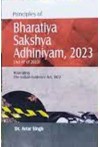- Author(s): Dr. Avtar Singh
- Publisher: Central Law Publications
- Edition: 25 Ed 2025
- ISBN 13 9788119415342
- Approx. Pages 656 + Contents
- Format Paperback
- Approx. Product Size 24 x 16 cms
- Delivery Time 3-5 working days (within Kerala & South India) (Others 7-9 days)
- Shipping Charge Extra (see Shopping Cart)
......................................................................................................................................
Description
In the preface of the First Edition of the "Principles of the Law of Evidence" Published in 1977, the author Dr. Avtar Singh had stated, "This book is an Introduction to and a brief study of the principles of the Law of Evidence that underline the provisions of the Indian Evidence Act. The Act has already completed a century of his magnificent existence on the Statute book. It has remained largely untouched during these hundred years." He dedicated his work in 1977 as a humble tribute to the brilliant success of the Evidence Act, 1872. Though he mentioned about redundancy of certain references to British empire and the requirement of having additional provisions in the Act but he had the firm opinion that the provisions of the Act were virtuous beyond all doubt.
Today after incorporating the provisions of the Bharatiya Sakshya Adhiniyam in the 25th edition of the book, I totally agree with his opinion. Apart from removing few redundant references and amended placement of provisions, only a few substantive changes have been brought in the Bharatiya Sakshya Adhiniyam, 2023. The present edition has been thoroughly revised to cover provisions of Bharatiya Sakshya Adhiniyam, 2023 including changes in numbering of sections. In older case laws, new sections of the Bharatiya Sakshya Adhiniyam are added in the brackets after the earlier sections of the erstwhile Indian Evidence Act, 1872.
The edition is also updated with the latest case laws after the last edition in 2020. The Supreme Court had the occasion of discussing the principle of parity that a criminal court should decide like cases alike. It was held that when there is a similar or identical evidence of eyewitnesses against two accused by ascribing them same or similar role, the court cannot convict one accused and acquit the other. The Court also observed in another case that within the standard of preponderance of probabilities, the degree of probability is based on the subject-matter involved. Whether the issue is one of cruelty or of a loan on a pro-note, the test to apply is whether on a preponderance of probabilities the relevant fact is proved.
In a case, the question was whether a Gazette can be treated as independent evidence of a conclusive nature in itself? It was held that where the court has to form an opinion on the existence of a fact of a public nature, any statement of it in a Government Gazette is considered as a relevant fact.
......................................................................................................................................
Table of Contents
Part I
Chapter 1. Preliminary
Part II
Chapter 2. Relevancy of Facts
Part III On Proof
Chapter 3. Facts which Need not be Proved
Chapter 4. of Oral Evidence
Chapter 5. of Documentary Evidence
Chapter 6. of the Exclusion of Oral by Documentary Evidence
Part IV Production and Effect of Evidence
Chapter 7. Of the Burden of Proof
Chapter 8. Estoppel
Chapter 9. Of Witnesses
Chapter 10. Of Examination of Witnesses
Chapter 11. Of Improper Admission and Rejection of Evidence
Chapter 12. Repeal and Savings
......................................................................................................................................
Author Details
Avtar Singh

